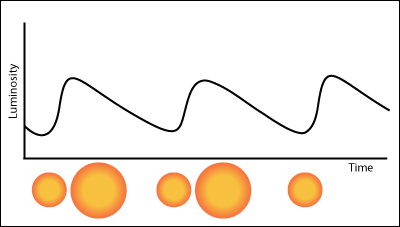Henrietta Leavitt and the discovery of Cepheid Variable Stars.
Distances in space were largely a mystery at the start of the 20th century.
The distances of some stars had been measured using a method called 'parallax'.

Finding distances of objects far out in space needed a new discovery.

The person who made that discovery was Henrietta Leavitt.
She discovered that certain types of variable stars changed brightness in a regular way.

These pulsating stars are known as Cepheid variables, named after the star Delta Cephei.
Henrietta Leavitt looked at large numbers of these stars in a feature called the Small Magellanic Cloud, and discovered that brighter Cepheids pulsed more slowly than dimmer ones.

The distances of some stars had been measured using a method called 'parallax'.

Finding distances of objects far out in space needed a new discovery.

The person who made that discovery was Henrietta Leavitt.
She discovered that certain types of variable stars changed brightness in a regular way.

These pulsating stars are known as Cepheid variables, named after the star Delta Cephei.
Henrietta Leavitt looked at large numbers of these stars in a feature called the Small Magellanic Cloud, and discovered that brighter Cepheids pulsed more slowly than dimmer ones.
So Cepheids act as 'standard candles'.

Measuring a Cepheid's 'pulsation time' tells astronomers how bright it really is.
By comparing the 'true brightness' with how bright it appears, they can work out how far away it is.